FROG F161 Fairey Barracuda |
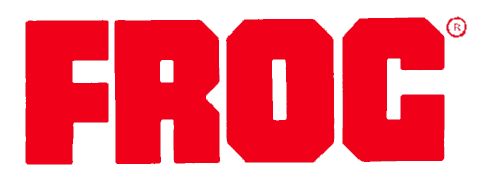
FROG F161 Fairey Barracuda, International Model Aircraft Limited, 1964
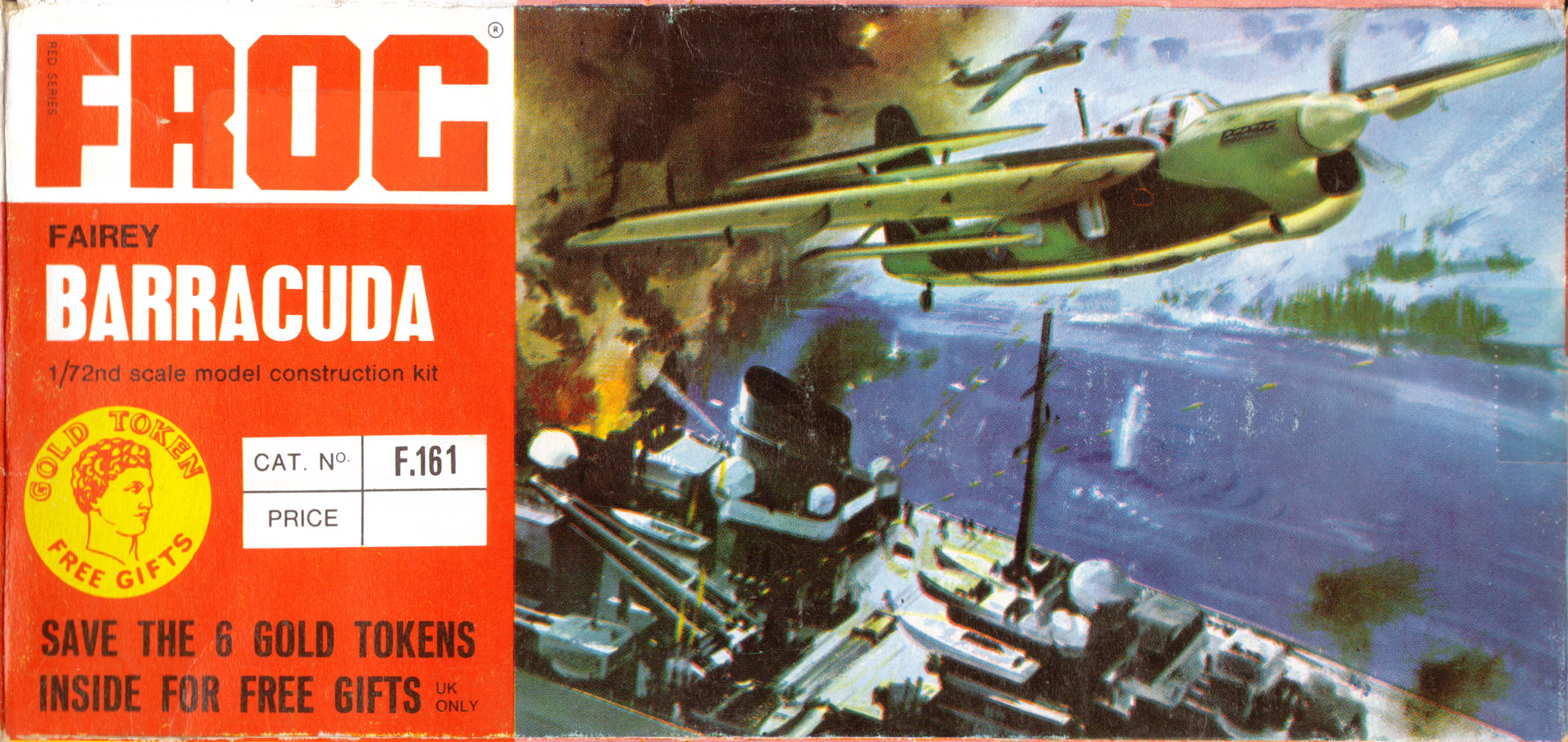
|
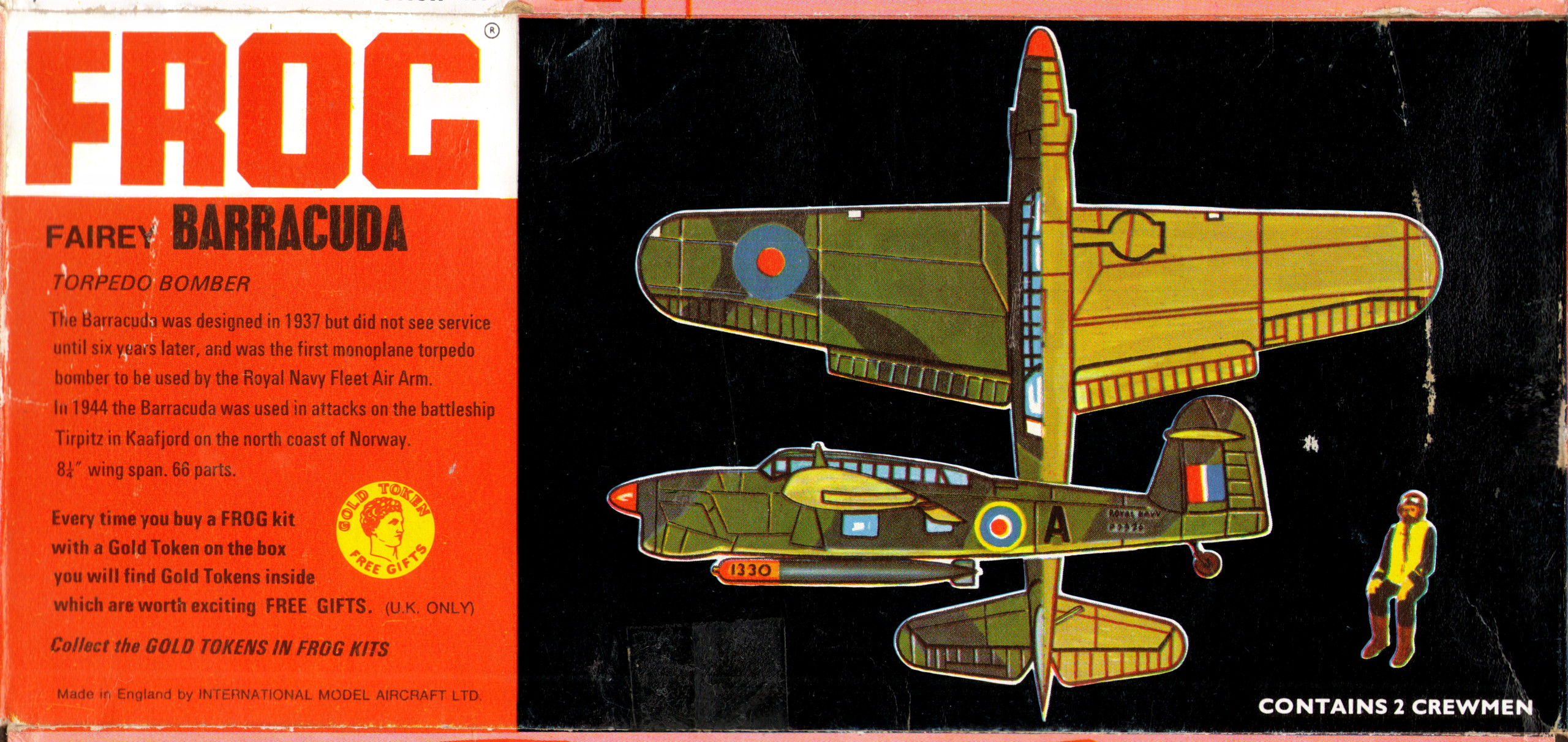





| F161 | 1964-1969 | F1(R) | 125000 | 1xFAA |
| F230 | 1970-1971 | G1(R) | 40000 | 2xFAA |
| F422 | 1972-1973 | J4(B) | 45000 | 2xFAA |
| F161 | 1974-1975 | H(R) | 20000 | 2xFAA |
Barracuda - единственный набор Frog, который когда-либо выпускался с тремя разными номерами (если не учитывать наборы Inside Story и другие специальные выпуски, затрагивающие некоторые другие наборы).
FROG model aircraft 1932-1976, R. Lines, L. Hellstrom
|
|
1964
В феврале вышел полноцветный каталог, посвященный исключительно наборам FROG. Учитывая быстрый темп выпуска новых моделей, это было замечательное начинание - включить в каталог все наборы, выпущенные в 1964 году, иллюстрированные или хотя бы упомянутые, за исключением Barracuda. Общий ассортимент достиг около 80 предметов.
FROG model aircraft 1932-1976, R. Lines, L. Hellstrom
|
ЗАМЕТКИ ПОКУПАТЕЛЯ
Компании Airfix и Frog продолжают идти параллельными путями в своих последних выпусках. Каждый из них выпустил Junkers Ju88A-4, а затем один из менее известных самолетов Королевского флота периода войны: Airfix - Grumman Wildcat Mk. VI, а Frog - Fairey Barracuda. Неизбежно возникает желание сравнить, особенно когда один и тот же объект предстает в двух сильно различающихся формах. Согласно официальному справочнику Люфтваффе, Ju88 A-4 должен иметь размах 20 080 мм, длину 14 359 мм, размах хвостового оперения 7 500 мм и расстояние между линиями тяги 5 430 мм. Каждый из этих наборов ценой 4/6d незначительно переразмерен, но по расстоянию между двигателями версия Frog значительно отличается (примерно на ¼ дюйма) от масштаба 1/72. Это, в сочетании с утрированным сужением консолей крыла, не передаёт облик этого знаменитого бомбардировщика. С другой стороны, один продуманный элемент, который нам понравился в этом наборе, это воспроизведение подфюзеляжной гондолы наблюдателя/бомбардира из прозрачного пластик. Этот продолговатый блистер можно окрасить, оставив неокрашенными только носовое и заднее окна, и в готовом виде он выглядит гораздо реалистичнее, чем обычная система отдельных окон.
В деталях Airfix Junkers демонстрирует больше характеристик, но все еще требует внимания в профиле руля и секциях крыла для привередливых. Оба набора, очевидно, упустили из виду малый размер опознавательных крестов на 88-м. Полный размер на крыле и фюзеляже был 1 квадратный метр, с 25 см. черными обводами, окаймленными 25 мм. белыми контурами. Финская свастика, отсутствующая в наборе, была квадратной 60x60 см. с 25 мм. контуром белого цвета.
Схема камуфляжа для нашего Frog Ju 88 - светлый песочный / темный земляной узор, взятый из книги Карла Риса о схемах, дизайнах и опознавательных знаках Люфтваффе, а показанная регистрация является точной для этой же машины, вооруженной разведывательной версии, действовавшей на Средиземноморском театре.
Frog Fairey Barracuda в 3/- оставляет желать лучшего как по простоте и скорости сборки, так и по точности. Шасси этого необычного самолета собираются с трудом, но в собранном виде выглядят правильно. Камуфляжная схема Frog, на наш взгляд, неверна, и та, что показана на нашей иллюстрации, скорее всего, будет точной.
Сборка модели Wildcat 2/- от Airfix заняла около трёх часов (включая покраску) и превратилась в действительно привлекательную модель. Единственный момент, который мы бы поставили под сомнение, это серийный номер и маркировка "Royal Navy", которые Airfix напечатала на своем переводном листе ярко-синим цветом - конечно, они должны быть черными! В остальном, это отличный маленький набор для завершения увлекательной подборки за месяц, выпущенный по ценам, которые являются минимальными по мировым стандартам и представляют собой огромную ценность.
AeroModeller JANUARY 1965 Vol.XXX No.348
За прилавком
Последние поступления пластиковых масштабных моделей происходят не так быстро, как можно было бы ожидать, учитывая рождественский период. Airfix ограничились Grumman Wildcat (2s.), который, несмотря на очень хороший стандарт, немного разочаровал тех из нас, кто надеялся на Ju.52 в нашем чулке!
Frog оказались наиболее трудолюбивыми, и WW.II была представлена Ju.88 за 4s. 6d. и Barracuda за 3s. Если Airfix Ju.88 критиковали за слишком квадратное сечение фюзеляжа и мотогондол, то модель Frog - наоборот. Пулеметная гондола под носом является отдельным элементом, который, хотя и создает ещё один стык, который нужно зачищать, но облегчает модификацию в вариант истребителя.
Барракуда" действительно очень хорошо выполнена, и единственная реальная критика возможна в отношении воздухозаборника радиатора и кабины пилота. Оба они откровенно пусты, но это можно исправить, добавив кусок сетки в первом случае и два куска обрезков бальзового листа (чтобы изобразить лонжероны, проходящие через фюзеляж) во втором. Предоставив только двух членов экипажа, Frog, казалось бы, оплошал, но, хотя Barracuda была рассчитана на экипаж из трех человек, на самом деле она обычно эксплуатировалась с двумя, т.е. пилотом и стрелком/радиооператором.
В серию "Trail Blazer" также были добавлены две модели: Spirit of St. Louis - самолет Линдберга для первого одиночного пересечения Атлантики и Westland Wallace, использовавшийся для первого полета над вершиной Эвереста. Обе модели чрезвычайно хороши и просты в изготовлении. Обратите внимание, что область верхней обшивки фюзеляжа Wallace должна быть окрашена в черный цвет, как показано на иллюстрации крышки коробки, а не в соответствии с инструкцией по окраске. Стоимость каждого из этих наборов - 3s.
Model Aircraft март, 1965
|
|

FROG F230 Fairey Barracuda, Rovex Limited, 1970
Scale Models 1971 FEBRUARY
NEW TO YOU?
Bob Jones surveys new releases
New from Frog
Одним из самых совершенных истребителей Второй мировой войны с поршневым двигателем был FOCKE WULF ТА 152, разработанный Куртом Танком. К сожалению, он поступил в производство слишком поздно, чтобы появиться в большом количестве, но в тех случаях, когда пилоты союзных истребителей встречались с Та 152, им было трудно соответствовать возможностям этой машины, Несмотря на сравнительную редкость этого типа, мы были рады получить от фирмы ROVEX TRI-ANG LIMITED образец для обзора их нового набора Та 152Н в масштабе 1/72, таким образом предоставляя энтузиасту Люфтваффе еще один "редкий тип" для своей коллекции. Отлитый из пластика средне-серого цвета, деталировка поверхности очень тонкая, и мы приветствуем этот тип рельефной детализации поверхности, которая намного превосходит более раннюю тяжелую деталировку заклепок и линий панелей.
Сборка довольно проста, подгонка деталей отличная, дополнительная деталировка включает сиденье пилота и бронированный заголовник в комплекте с бронированной плитой сиденья, которая так заметна на этих самолетах. Фонарь кабины пилота должен быть оценен как один из лучших, он отлично подогнан и правильно "выпуклый", как на оригинальном самолете, четкость немного искажена вдоль верхней части фонаря из-за толщины прозрачного пластика, но это неизбежно и не ухудшает внешний вид модели, если только свет не падает на кабину под определенными углами.
Контуры модели в основном точны, хотя сужение крыла вдоль задних кромок немного чрезмерно, а детали капота довольно упрощены, как и расположение выхлопных патрубков.
Декали предназначены для машин 2 Staffel/I Gruppe/JG.300, участвовавших в операциях по защите Рейха, а альтернативная маркировка - для машины 1 Staffel/I Gruppe/JG.3. Национальные знаки отличия и опознавательные знаки подразделения включены, как и правильные номера Werke, где это применимо. Декали имеют плоское матовое покрытие и хорошо приклеиваются, гладко ложась на различные детали панелей.
Художественное оформление пакета НЕ соответствует обычному стандарту ROVEX, но художественное оформление типа Profile, предлагаемое в качестве руководства по окраске на обратной стороне пакета, как обычно, превосходно. В одном из первых номеров мы поместим статью об исправлении одной или двух основных неточностей этого набора, а также фотографии нашей готовой модели и подробности о том, как добавить дополнительные усовершенствования к деталям набора. С длинными тонкими крыльями и тонким фюзеляжем этот самолет выглядит очень привлекательно, и набор, несомненно, окажется очень популярным.
Очередной выпуск от ROVEX TRI-ANG LIMITED порадует энтузиастов Fleet Air Arm - это набор из коробки для ударного истребителя WESTLAND WYVERN, одного из послевоенных типов авианосцев ВМС, который участвовал в боях во время шестидневной Суэцкой "войны".
Снова отлитый из пластика среднего серого цвета, этот набор, должно быть, один из лучших, выпущенных этой компанией. Компания Westland Aircraft (как и прежде) оказала полное содействие и помощь, а разработка набора сама по себе является прекрасным примером тщательного планирования, в результате чего получился набор, который действительно предоставляет моделисту великолепную основу для сборки "прямо из коробки" или для постройки "сверхдетализированной" копии оригинальной машины. Сборка следует обычной практике и упрощена, не умаляя деталировки, применимой к данному типу. Особого внимания заслуживает тонко детализированное шасси с маслоамортизаторами и колесами/втулками, а поверхностная детализация включает огромные закрылки и консоли крыла.
Интерьер кабины состоит из всех панелей приборов (с выгравированными на них изображениями индикаторов), а также прекрасной копии сиденья пилота, броневой пластины и заголовника, фигурка пилота также включена, хотя и не очень удовлетворительная, и отдельная рукоятка управления также входит в комплект.
Подкрыльевое вооружение включает двухъярусное ракетное вооружение, а дополнительные детали позволяют моделисту установить хвостовое колесо/шасси машины в убранном или выпущеном положении.
Фонарь кабины пилота действительно великолепен, и мы бы добавили, что следует обратить пристальное внимание на руководство по окраске в стиле Profile на задней стороне коробки, чтобы убедиться, что каркас фонаря окрашен правильно. Фонарь Wyvern состоял из отдельных секций, которые были просто соединены вместе без какого-либо металлического каркаса, поэтому очень легко случайно закрасить имитацию линий соединения, думая, что это металлический каркас. Декали превосходны, они предназначены для ударного самолета 830 Squadron, HMS Eagle, 1956 периода Суэцкого кризиса, а альтернативная маркировка дана для машины 287 Squadron, HMS Eagle 1955. Лист декалей включает национальную маркировку, эмблему и герб эскадрильи, а также обычные серийные номера и коды.
Окраска "Wyvern " была глянцевой Extra Dark Sea Grey сверху с нижними поверхности, оперением, рулями и бортами фюзеляжа цвета Sky - обратите внимание, что цвет кока и оперения на машинах 830-й эскадрильи был вишнёво-красным, а не красным или бордовым, как показано на коробке, на машине 827-й эскадрильи только кок имеет стандартный глянцевый красный цвет.
Интерьер кабины пилота был Night finish, матово-черным, а подкосы шасси и т.д. были полированным металлом, интерьер ниш шасси также был цвета натурального металла, хотя на некоторых машинах он был цвета Sky.
Как и в случае с рассмотренным ранее Та 152, мы опубликуем подробную статью о постройке Wyvern в одном из первых выпусков, но если вы не можете ждать этого, то можно собрать набор "прямо из коробки" и получить восхитительно точную и наиболее впечатляюще выглядящую модель. Особенно приятно видеть, что производители наборов выпускают наборы машин пятидесятых годов, так как на ум приходит много интересных типов, которые были бы современны Wyvern.
Старые фавориты в новой маркировке
За последние двенадцать месяцев или около того наборы, выпущенные компанией ROVEX TRI-ANG LIMITED, отличались очень высоким качеством переводных листов, и неудивительно, что компания недавно перевыпустила три своих старых набора с новыми декалями и коробками.
Это FAIREY BARRACUDA, WESTLAND WESSEX и FAIREY GANNET - каждый набор сам по себе очень хорошего качества, а BARRACUDA всегда была популярна среди моделистов - оригинальные формы остались неизменными, но коробки теперь имеют совершенно новое художественное оформление, а декали в каждом наборе гораздо более полные и действительно представительные, чем в оригинальных предложениях. Маркировка набора BARRACUDA теперь предназначена для одной машины 829 эскадрильи H.M.S. Victorious, действовавшей во время налетов на немецкий линкор TIRPITZ 1944 года, в то время как альтернативная маркировка дана для машины 812 эскадрильи BRITISH PACIFIC FLEET 1944/5. Особо следует отметить наличие на листе декалей шнурка, который крепился в нижней части задней части фюзеляжа и, когда за него тянул стрелок или наблюдатель, поднимал люк для укладки шлюпки в воздушный поток, тем самым гарантируя, что шлюпка не окажется в ловушке в разбитом и тонущем самолете.
WESSEX Mk. 31 имеет маркировку и камуфляж машины из 817 эскадрильи Королевского австралийского флота на борту H.M.A.S. MELBOURNE или, в качестве альтернативы, из 845 эскадрильи Fleet Air Arm на борту H.M.S. Albion в окраске сил Commando. Принимая во внимание оригинальное качество и точность этих наборов, мы уверены, что все они получат новую жизнь в новой отделке.
Трио перевыпусков от Frog - Barracuda, Wessex и Gannet, каждый по 4/9d. и теперь с измененной маркировкой. Эти самолёты военно-морских сил имеют широкий спектр возможных окрасок, и мы опубликуем фотографии других вариантов в следующем месяце.
Scale Models No.17 1971 FEBRUARY Vo2. No.2
|

FROG F422 Fairey Barracuda, Rovex Limited, 1972

|
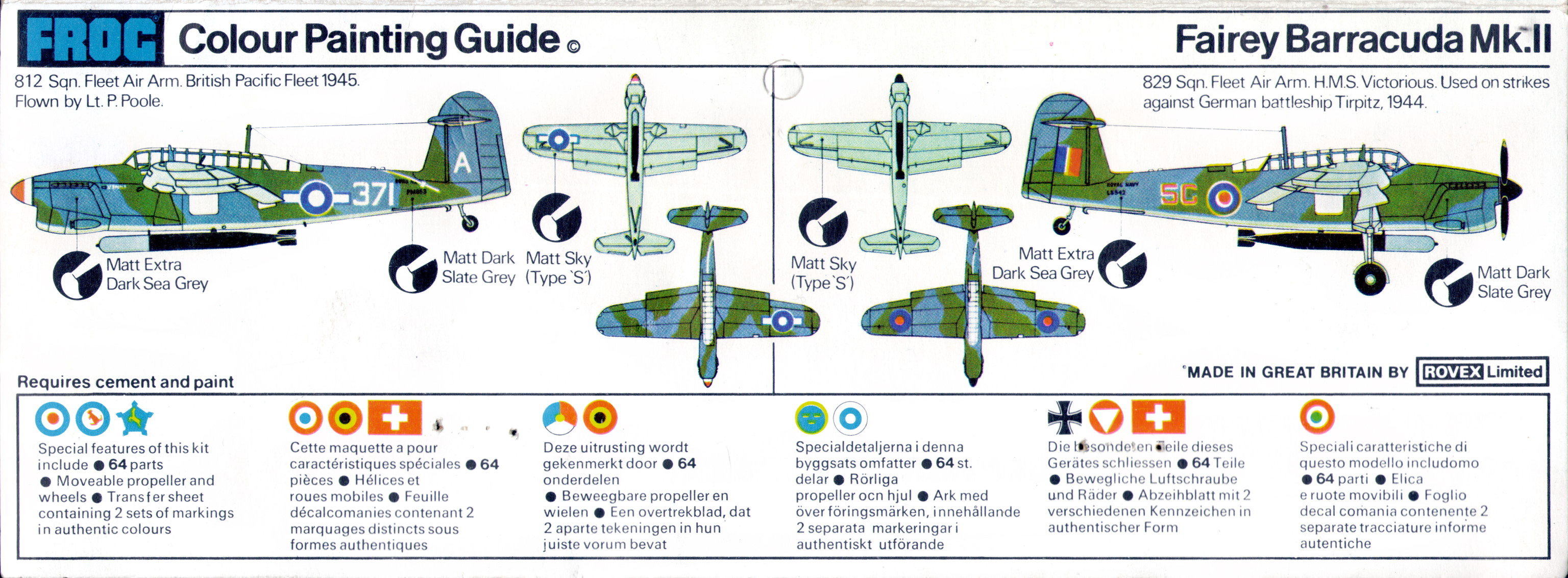

|
КОММЕНТАРИЙ К КОМПЛЕКТУ
БОЛЬШЕ ОТ FROG
Одновременно с выпуском модели Wildcat от Frog были выпущены три других набора. Два из них, Barracuda и Lysander, являются переизданиями в пакетах, а не в коробках, в то время как третий является еще одним новичком - Fiat G.55. Это снова довольно привлекательный набор, который отличается необычной особенностью: створки хвостового колеса и сиденье кабины пилота отлиты вместе с половинками фюзеляжа.
Aviation News Vol 1 Num 13 10-23 November 1972
Мир моделизма
Новые британские наборы самолетов времен Второй мировой войны
Frog Barracuda точна в очертаниях а, с добавлением деталей радиатора и кабины пилота, превращается в хорошую модель.
AIRCRAFT ILLUSTRATED 1972-11
Мир моделизма
Большое количество новых наборов
Два ранних набора, для Westland Lysander и Fairey Barracuda, были переизданы в упакованном в пакет виде. Оба набора хороши. Barracuda - единственный доступный набор этого военно-морского ударного самолета, и хотя ему уже много лет, он по-прежнему является точным представлением полноразмерного самолета.
Стоимость этих наборов - 24 пенса каждый.
AIRCRAFT ILLUSTRATED 1972-12
НОВОЕ ДЛЯ ВАС?
Лихорадка новых наборов и переизданий продолжается - обзор от Боба Джонса (I.P.M.S.) и Scale Models.
Переизданные Fairey Barracuda и Westland Lysander остались неизменными, за исключением того, что теперь они оба отлиты из средне-серого пластика. Это два хороших набора, которые энтузиаст может улучшить, добавив свои собственные детали интерьера кабины и т.д., декали для "Барракуд" 812 Sqdn., British Pacific Fleet, 1945, и 829 Sqdn. F.A.A. H.M.S. Victorious, летавших на удары по Тирпицу в 1944 году, но обратите внимание, что ни одна "Барракуда" не летала с торпедой; цвета камуфляжа - из набора красок Humbrol Fleet Air Arm Camouflage, интерьеры обеих машин - авиационная серо-зеленая краска Humbrol HB.1.
Scale Models No.40 1973 JANUARY Vol.4. No.1
|
|
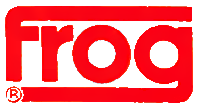
FROG F161 Fairey Barracuda, Rovex Models & Hobbies Limited, 1974
|

Air Lines 7902 Fairey Barracuda, Lines Bros., Inc., 1964
Air Lines
Lines Bros., Inc., 1107 Broadway, New York, NY, USA.
Period: 1964-1966
The first U.S. distributor of Frog kits was H. Hudson Dobson in New York, who sold the pre-war Penguin kits. When plastic kits were re-introduced in the 1950s, distribution was handled by Lines Bros., Inc., and also by Continental Models, Inc., in Brooklyn, New York. Incidentally, Continental also handled most of the Airfix imports. However, all imports of plastic kits were subjected to high customs tariffs and sales were therefore relatively low. It was to cure this situation that Air Lines were born.
Air Lines was the brain-child of Alan Ginsburg, the local Lines Bros, manager. His suggestion was to have all the kits moulded in the U.S.A., thus avoiding the tariffs. He eventually persuaded the management in London that this was a sound proposition and an initial range of 24 kits was selected. After visiting a number of potential candidates -bringing a sample Frog mould in the car boot - an agreement was reached with Pyro in New Jersey to mould the kits.
Most Frog kits at the time had a line drawing rather than dramatic artwork on the box and this was felt to be unsuitable for the U.S. market. The artist Jo Kotula was therefore commissioned to paint new art for Air Lines, many of his paintings later being used on Frog kits as well.
All decals were printed in England and, apart from the new ones for the USAAF B-25 and B-26, the same as in the contemporary Frog issues.
Instead of the normal U.S. practice of adding the price after the kit number. Air Lines incorporated it in the number itself. Kit 3901 thus cost 39 cents, and so on.
It should be noted that the Vimy was never sold with radial engines, although shown thus in the Air Lines leaflet.
The first kits appeared in 1964 and a further five kits (7908, 9803, 9804, 12903 and 12904) were added in 1965. The last kits to be released were the 59 cent range in spring, 1966. However, by now it was apparent that the whole scheme was in fact uneconomic and Air Lines was terminated later in that year, an additional five kits planned for August never being produced.
Production quantities are not known but must have been substantial for most kits, judging by the numbers still around.
FROG model aircraft 1932-1976, R. Lines, L. Hellstrom
|
|
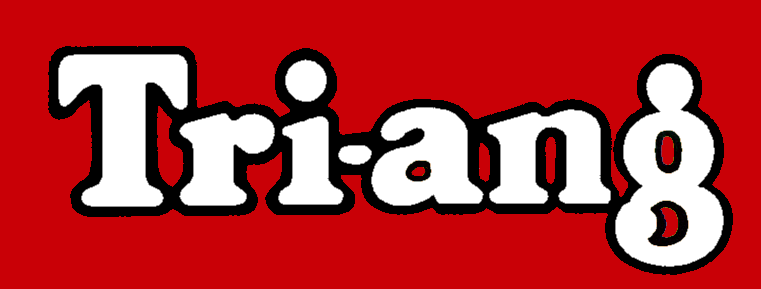
Tri-ang F162 Blackburn Skua, Lines Frères S.A. Calais, 1964
Tri-ang/Frog (France)
Lines Freres S.A., Route de Dunkerque, Calais, France (to mid-1964);
Meccano - Tri-ang Lines Freres S.A., 70-88 Avenue Henri Barbusse. 93 Bobigny. France (from mid-1964)
Period: 1962?-1972?
The French production was a very large operation, only surpassed by the Soviet activities of recent years. Despite this, very little has been known about it, never mind published.
The origins can be traced back to the founding of EEC in 1958. Since Great Britain was not a member state at the time, the Lines Bros, management wanted to get a foothold on the continent by establishing a branch in France. It needed to be close to the Channel coast in order to make the shipping of moulds back-and-forth as easy as possible. However, no suitable existing factory could be found so in the end a completely new facility was built on the outskirts of Calais.
The general idea was to send moulds over from England and having the actual production taking place in France -an EEC member - thus making the products duty-free when exported to other EEC countries. The production did not only include kits - indeed, this only accounted for some ten per cent of the capacity - but general toys as well.
At first, all kits produced were sold under the Tri-ang label, mainly in order to conform with the other French products. But no doubt the word Frog was also considered less suitable due to certain associations in British-French relations...
No production records have survived, but it seems likely that most contemporary Frog kits were produced in Calais as well. The Tri-ang boxes, decals and instruction sheets were all copied from the British originals and only showed minor changes. Plastic colours could differ from the normal Frog ones however, some startling combinations like red Scimitars being produced.
Kit numbers were the same as those used in Britain. However, many of the kits can be found with a C-prefix to this (e.g. C.334P). This was also used on other Lines products manufactured in France and stood for Calais. It seems to have been used up to mid-1963 or so and then deleted from future boxes printed. Some kits can therefore be found both with and without the C-prefix. When IMA changed from a suffix-P to a F-prefix in 1964 the French followed suit for a short period. Kits already in production were not changed, however.
Early in 1964 Lines Bros, bought the Meccano group and - almost as a bonus - also got control of their French branch. Meccano was already a well-established name in France - much more so than Tri-ang - and the two companies were therefore quickly integrated, the Meccano name being worked into the Tri-ang brand name on most products. The existing Meccano manager became the new managing director for France. He had no objection to the name Frog - indeed, he thought it a good joke! - and their kit range was thus renamed Frog/Tri-ang.
A new box style and new artwork was adapted for new releases. For reasons unknown, these also reverted to the old suffix-P. Kits already in production were not changed, apart from getting a sticker indicating the colour series when appropriate (red for the Attacker etc.). There is no known example of an old kit being given a new box. The fact that the Britannia was released in this style is admittedly confusing, but probably only indicates that it was never issued in the early style for some reason.
It should be pointed out that Tri-ang did by no means handle all sales to the continent. Managers of the continental Lines Bros, selling branches did, of course, buy where the price was lowest and Tri-ang prices were often higher than those of IMA. Lines Bros. (Holland) NV did, for example, mainly buy British-made kits.
By 1966, kit production was becoming uneconomical and was consequently terminated before long. This was partly caused by poor sales and partly due to problems in planning the mould swapping programmes. In early 1967 some 50000 standard Frog boxes were sent over from Britain and most remaining Tri-ang stocks reboxed - in some cases this was done by simply putting a new box over the existing one. But for certain kits, such as the ships, airliners and small-scale WWII bombers, no new boxes were available and old stocks of these were still sold as Tri-ang in the early 1970s.
Although not yet positively proved, it is believed that the moulds for the Rapide, Rotodyne and small-scale Blenheim, Hampden and Wellington were left behind in France and eventually scrapped there.
Some special issues are also worth a mention. In 1968 an ex-Heller Mirage IIIC was released under the Frog/ Meccano-Tri-ang label and this was joined by another three ex-Heller kits in 1971. These are the only kits known to have used the Frog name without ever having been produced by either IMA or Rovex. For some reason, some of these kits were also sold as Meccano-Tri-ang kits as well, without reference to Frog. Possibly this was after the Airfix take-over.
In the early 1970s Meccano was bought by Airfix and it is an ironic fact that from 1982 the former Lines Bros, factory in Calais produced all Airfix kits intended for the European market...
It is possible, but not very likely, that the ex-Renwal AFV and ship kits sold as Frog in England were also sold as Tri-ang. Since they are not really ex-Frog kits, nor used the name Frog in France, they have been excluded from the list.
"New" Style
| * | 161P | Fairey Barracuda II |
FROG model aircraft 1932-1976, R. Lines, L. Hellstrom
|
|

UPC 5086 Blackburn Skua, Universal Powermaster Corporation, 1967
UPC
Universal Powermaster Corporation, New York 10, NY. USA
Period: 1967-1970?
Compared to most other kit companies, UPC is something of an oddity. They had a very large number of kits in their range - more than 150 at one time or another - but they never made any moulds of their own. Instead they repacked kits from countless other manufacturers and sold these under the UPC label. The company was apparently more or less a "one-man show" under the management of Mike Tager.
The first Frog kits bought were the ten ship kits, in quantities of 15-25,000 pieces each. The R.100, Gannet, Barracuda, Beaufort and Lancaster followed in 1968 with the rest of the aircraft in 1969. Quantities varied between 10,000 and 20,000. The 5,000 Jaguar kits were scheduled for 1968 but eventually delayed until the following year. Most kits had new artwork but used stock decals supplied by Rovcx. Instruction sheets were standard Frog, except for a change of logotype.
The R.100 came without the cardboard base of the Frog issue. A UPC R.100 with kit number 6040 has been reported elsewhere, but this is probably just a misprint.
For four of the aircraft kits the situation is a bit unclear. UPC ordered 10,000 pieces each of these, and apparently at least some were produced by Rovex of all except possibly the Mosquito, but their issue by UPC is still not confirmed. Were they in fact issued, they probably got kit numbers in the 51 xx range.
FROG model aircraft 1932-1976, R. Lines, L. Hellstrom
|
|
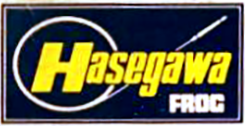
Hasegawa/Frog JS-043 Fairey Barracuda, Hasegawa Seisakushu Ltd. Co., 1969
Hasegawa/Frog
Hasegawa Seisakushu Ltd. Co., 600-6, Higashi Nitta. Shizuoka-Shi, Japan
Period: 1967-1974?
The co-operation between Frog and Hasegawa is one of the most successful between two independent companies and also one of the most extensive. But it is not unique. Airfix had a similar arrangement with Eidai during the same period, to mention one example, although this was limited to Eidai selling Airfix kits and not vice versa.
The first contacts were made by Rovex in early 1967, on the suggestion of UPC - themselves large buyers of Japanese kits and also a customer of Frog mouldings. Initially both LS and Hasegavva were considered as potential suppliers, but the latter was soon found to be the better of the two.
Under the agreement reached, all kits were moulded by the originating company who sold the bagged mouldings to the other company. Hasegawa thus added boxes, instructions and decals at their own factory. The decals used were often based on the original Frog ones, although in some cases changes were made by adding or deleting options. E.g., the Vimy had RAF decals, the Ju 87 Hungarian markings only and the P-38 an additional two USAAF options apart from the two in the Frog issue. All box artwork was new and of good quality.
Hasegawa was one of the few companies to issue former Frog kits in more than one box style. The first kits came with the old Hasegawa logotype, but around 1969 this was changed to the new one still in use today. Many kits can therefore be found with two different box styles. Unfortunately, no detailed information is available on the subject and the details given below should be considered as provisional only.
It should be noted that the Ju 88 and Beaufighter were first sold in their original form and later on with Spin-a-Prop modifications added (although never sold as Spin-a-Prop kits by Hasegawa).
The reason for discontinuing the co-operation between the two companies is not quite clear, since both sides were apparently satisfied with the arrangement. The probable reason is that the receivership imposed on Rovex in the early 1970s caused a desire to withdraw from any long-term commitment. Be this as it may, Rovex delivered the last batch of mouldings in early 1973, and these were probably sold out by Hasegawa within the year.
The Hasegawa kit numbers were allocated roughly in order of issue, the last new Frog kits being released in 1971. While most kits did have the JS-prefix to their numbers, it is worth noting that at least some of the new style boxes (e.g. that for the Shark) lacked this.
The production quantities given below are based on incomplete information and should therefore be treated as strictly provisional.
Repeated inquiries to Hasegawa regarding some of the above have, unfortunately, remained unanswered. Of all the companies contacted, they are one of the few not to respond in any way.
| | Boxes |
| | | Old | New | Qty |
| JS-043 | Fairey Barracuda II | x | ? | 35000 |
FROG model aircraft 1932-1976, R. Lines, L. Hellstrom
|
|

Novo Cat.No.76022 Fairey Barracuda, Novo Toys Ltd., 1978
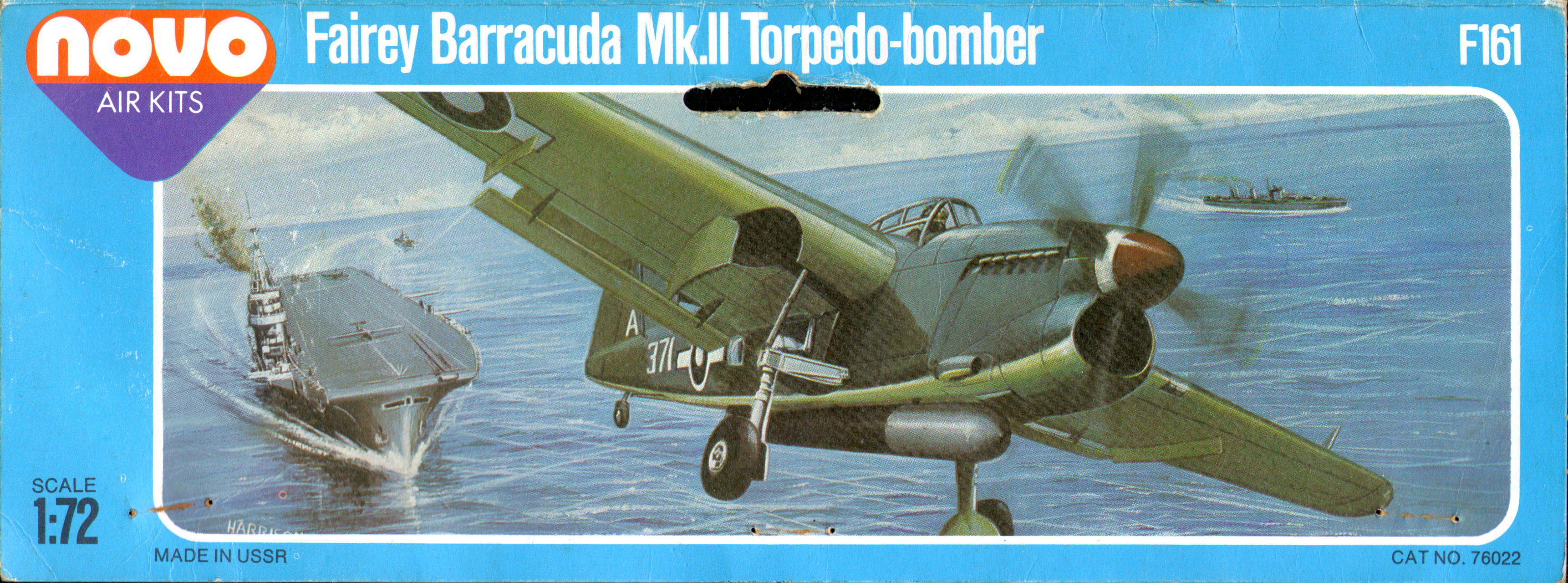

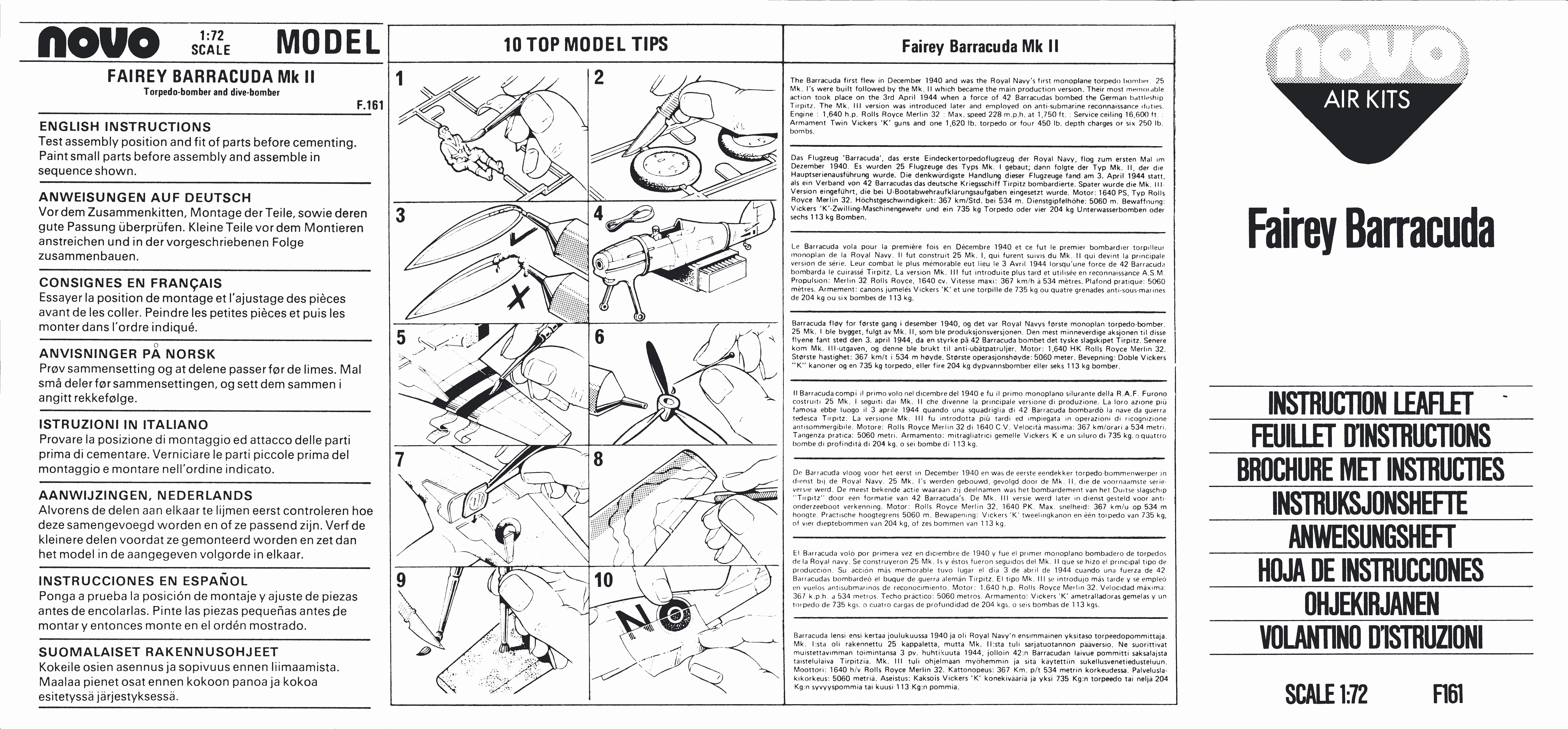

Novo
Novo Toys Ltd., Maxey, Peterborough, England PE69HQ
Period: 1976-1981
Few, if any other kit companies have been subjected to as much rumour spreading, speculation and ill-informed guesswork as Novo. Neither has any other company name been so misused, and perhaps it is best to start by putting this straight.
As can be seen above, Novo was a British company, and it always was. Although the company name itself was derived from Novoexport, their Soviet trade partner, Novo was never owned by the Russians. In recent years, Novo has been used as a collective name for any ex-Frog kits coming out of the USSR, but nothing could be more wrong or misleading. Only kits actually packed in Novo packaging should be called Novo kits. Anything else can only be described as kits by the Soviet factory in question (BFI, Krugozor, Tashigrushka etc.). If a collective name is really necessary, then one might perhaps use MLI (for the Soviet Ministry of Light Industry, who supervise most of these factories).
The events leading up to the creation of Novo have been covered in the Frog history section of this book and will not be repeated here. Suffice to say that a General Agreement was reached between Dunbee-Combex-Marx (the owner of both Novo and Rovex) and V/O Novoexport in August 1975. This agreement stipulated that DCM was to deliver moulds, tools and materials to Novoexport, who would pay for them by sending back finished goods from the same moulds. It must be pointed out that apart from model kits the agreement also covered a wide range of other toys. Novo Toys Ltd. was set up by DCM in 1975 to handle this business.
The finer details of the arrangement were set out in twelve contracts, three of which concerned the ex-Frog kits. A theoretical value (based on remaining production life and other factors) was set for each mould. These were totalled for each contract and a suitable mix of kits to the same amount was worked out, meaning that payment for a particular mould did not necessarily consist of kits from that very same mould only.
Once the agreed quantity of kits had been delivered by Novoexport, the moulds were considered their property and all future purchases by Novo had to be paid for in cash. In the event, no such follow-up orders were ever placed by Novo.
The first moulds were sent out to the USSR in early 1976 (i.e. almost a year before Frog production by Rovex finally ceased) and these were distributed among the several Soviet factories undertaking the actual production. With the exception of the Dennis Ambulance, Firefly Dinghy and the Axis aircraft sold to Revell, all Frog moulds still with Rovex in 1976 were shipped to the Soviet Union over the next year or so. Of these, the Britannia, R-100 and the car kits were considered to be of little interest to the Western market, and consequently no Novo numbers were ever assigned. Although not specifically mentioned in any contract, it is believed that the Soviets also took delivery of the old Drifter and Tug Boat moulds.
The Novo kit number incorporated the original projected year of release (e.g. 76001). Some kits were in fact delivered to Novo in 1976, but not until 1977 was a marketable range available and released. Due to this, no additional kits were planned for 1977, but instead delayed until 1978 and given numbers starting with 78. The many gaps in the sequence were partly filled by other Novo products.
Getting the Russians to keep up with the delivery schedule was the main Novo headache. From the very start and until the very end, Novoexport were constantly behind in their deliveries. The reasons were of course many, but a few of these warrant some comments.
Problems with production facilities and moulds were common. Although certain Soviet factories were fairly well-equipped, others had obsolete and unsuitable machinery. Staff competence and maintenance levels also sometimes left something to be desired. This not only slowed down production, but also led to some moulds being damaged. The Mirage mould, for example, was left out-doors one winter and was of course thoroughly rusty by spring! (It was later restored to usable condition.)
The mould for the old Typhoon, when returned to the UK for repairs, was found to be missing all six original locking bolts holding the two halves together. These had been replaced by four new ones of inferior material. Had these broken during operation (remembering that plastic was being injected with a pressure of over 500 p.s.i., or 35 kp/cm2), the mould would probably have been completely destroyed along with the injection machine and its unfortunate operator. The same mould had also been repaired by the Russians, using brass instead of toughened steel.
All in all, Novoexport complained about problems with some two dozen moulds. Of the eight subsequently repaired in the U.K., five had damage caused by the Russians.
But the main problem was the inferior plastic used in the USSR. All Frog moulds were tuned to use Shell SI73 polystyrene (or equivalent), having a Melt Flow Index of 35. Soviet polystyrene, on the other hand, was found to have an index of around 4! This meant that, in order to make the plastic fill the mould, the temperature had to be increased by some 50°C and the injection pressure up to 100%. Not only was this very damaging to the moulds (several subsequently had to be repaired), but also often led to sub-standard mouldings. This since the extreme pressure forced the mould halves apart, letting plastic overflow into the gaps and form flash.
Neither was the low MFI the only problem with the plastic. An independent evaluation carried out in 1978 reads like a catalogue of faults: "Izod (= impact strength) very low .. . abnormally low I.V. (= inherent viscosity) . .. colour is poor and contamination excessive ... poor surface finish and gloss ... extremely brittle and not very rigid .. . must make good colouring difficult and appearance of finished article to be doubtful quality."
The third major problem was politics. Soviet laws take a pretty grim view of anything "fascist", which was why all German, Italian and Japanese aircraft were sold to Revell instead of being sent to the USSR. But other problems were to come up.
The original boxes for the Tupolev SB-2 showed one Luftwaffe marking alternative. Novoexport refused point-blank to touch these and Novo eventually had to print a replacement batch of some 105,000 box bottoms. The Luftwaffe portion of the decals were also cut away.
Later on, the Soviet Ministry of Culture classed the Fokker D.XXI as a "fascist aircraft" since it had been used by the Finnish AF in WWII. The fact that the Finns also used e.g. M.S.406, P-40, Lysander, SB-2, Hurricane, Gladiator and Blenheim - all of which were also included in the Novo range - did not seem to bother them, however. Subsequent Novo attempts to get this decision changed were all in vain. It should be noted that Novo had replaced the original Finish AF marking alternative with a Danish one, to avoid this very problem.
The next casualty was the Sea Fury. Due to a slip-up, the 1980 Novo catalogue described it as having shot down some MiG-15s during the Korean War. Novoexport were much upset by this and refused to deliver any more Sea Fury kits! Only a few kits from an earlier trial consignment ever reached the market. The same fate probably befell the Sea Venom, only this time the catalogue mentioned Egyptian MiGs destroyed in 1956. Only a small number of Sea Venoms were delivered, anyway.
Despite all difficulties, business was good for Novo and their kits sold well - mainly due to very competitive prices made possible by the unique set-up of the production. The downfall of Novo was thus not caused by economical problems as has often been suggested, at least not directly. However, Dunbee-Combex-Marx Ltd. fell into severe financial difficulties in 1979 and eventually had to go into receivership. Since DCM owned Novo, legal requirements forced Novo to do the same and the company passed into the hands of the receivers in February 1980. No buyer could be found in time and Novo Toys Ltd. was wound up later in the same year, although formal liquidation only took place five years later.
The last Soviet deliveries were made in mid-1980 and all kits had been sold out by early 1981. Remaining stocks of boxes, decals and instruction sheets (all printed in the UK) were handed over to Novoexport together with some original box artwork and other bits and pieces.
Box styles, artwork, decals and instructions were in general very similar to the late Frog issues. Indeed, early box mock-ups were almost identical to the Frog boxes except for the removal of the Frog logotype. Apart from the mock-ups, a small batch of similar test boxes were also printed before the style eventually used was finally agreed upon.
Although most Novo kits were boxed, it should be pointed out that kits 76001-76031 were packed in plastic bags with header cards.
Apart from box style, there were also some changes in artwork and decal sheets. Sixteen of the kits used completely new box top art and a few others had slightly changed versions of the Frog originals. In addition, five kits used art previously only utilised on Air Lines boxes.
The only all-new decals were those for the Dart Herald, F-82, Baltimore, VC10 and Boeing 707, although the first three probably had the new designs completed while still with Rovex. Either way, the design work was carried out by Dick Ward of Modeldecal. Apart from the previously mentioned Tupolev and Fokker, the only other known change was that the P-38 had its Chinese markings alternative replaced by a second USAAF one. Although the HMS Trafalgar box art showed the ship with the "RO9" pendant number of HMS Cadiz, the actual decals gave "D77" which was the post-war number of Trafalgar.
A great deal of speculation has taken place over the last few years as regards which kits Novo actually released. And this with some right, since it is indeed a very complex subject.
To begin with, a large number of kits were undeniably released. The kit listing which follows gives production quantities for these.
Secondly, certain kits belonging to the third phase of the third contract were definitely never released. They arc all marked "t" in the list, and for these kits no boxes, decals or instruction sheets were ever printed.
This leaves us with some twenty-three kits which were never officially released but nevertheless had all boxes etc. printed. In the list they all have the official production quantity zero. Regrettably, this does not represent the whole truth, and that for two reasons.
The first one is that trial consignments were often received by Novo and, although not included in the official production quantity, these kits were eventually sold by them. It is also possible that a few batches of slightly faulty and previously rejected kits were also sold out at a discount when Novo closed down. These consignments might number anything from a few dozen to several hundred kits, in some case perhaps more than a thousand.
In connection with this, the Boeing 707 is a special case worth mention. A batch of some 3,000 707s were received by Novo and quickly distributed. However, it was soon found that most kits suffered moulding defects and in the end all but a very few were recalled by Novo or returned to them by irate buyers.
The second reason is that when Novo closed down, Novoexport held enough "paper work" to produce another 2,750,000 Novo kits. It is a fact that some of this has since been used by the Russians. In many cases only the box has been used, omitting the decals and substituting the instruction sheet with a Russian one (or a photo-copy of the Novo original). But sometimes all three original items have been used and the only clue that these are "fake" Novo kits might be the somewhat odd plastic colour (Novo usually managed to avoid the more disgusting ones of the strange shades apparently beloved by Soviet plastic producers). However, in a few cases even this gives nothing away. Since these kits are produced in the same factories as before, using original Novo boxes, decals and instruction sheets, they are - for all practical purposes - Novo kits.
To give some (admittedly subjective) indication of the quantity known to exist of the "zero production" kits, one or two pluses have been added. Thus "0+ + " indicates that a reasonable quantity - perhaps a few hundred - has found its way on to the Western market. "0+" indicates that very-few, or none, have yet been seen. But this may of course change at any time; who knows when the Soviets decide to make use of their 46,000 sets of Twin Mustang packaging...
Finally, the four Russian aircraft - Anatra, MiG-3, LaGG-3 and Yak-3 - must also be mentioned. Produced by Rovcx in accordance with the 1975 DCM-Novoexport agreement, the moulds were kept with Novo in England for many years. But for various reasons they were never included in any of the actual contracts with Novoexport, nor were kit numbers assigned. When Novo closed down, the Russians were most interested in buying the moulds but lacked the hard currency needed. Later attempts by the receivers to sell them to other kit manufacturers - including Lindberg, Monogram, Revell and Starfix - all failed. Not until 1983 were they finally disposed of, to Red Star (which see).
Throughout the list, the Novo number has been given as kit number. But all the kits also carried the old Frog number on the box; indeed, on the 76xxx kits this was more prominently displayed than the Novo number.
| | Qty |
| | 76022 | Fairey Barracuda II | 70000 |
FROG model aircraft 1932-1976, R. Lines, L. Hellstrom
|
|
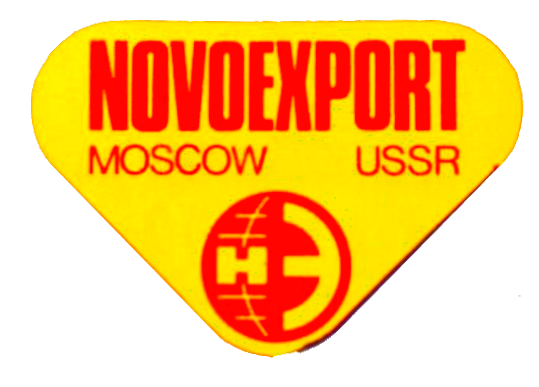
Novoexport Cat.No.76022 Fairey Barracuda, V/O Novoexport, not issued


Novoexport
V/O Novoexport, Bashitovskaya 19. Moscow 103287, USSR
Period: (1976 to date)
Novoexport is one of several state-owned Soviet export organisations, each specialising in a different type of merchandise, with Novoexport handling all sales of toys and similar goods.
Apart from the role played in connection with Novo (which see), Novoexport also had - and probably still has -an ambition to export kits produced from the old Frog moulds under their own name.
The first attempt took place in the mid-1970s, parallel to the introduction of Novo kits. Novoexport expressed a desire to export kits under their own name while simultaneously supplying kits to Novo. Novo had no objections and helped print a test batch of some 2,000 pieces each of fifteen header cards. No new instruction sheets were made, however. The cards were basically identical to those used by Novo, but with a red rather than blue border and a new logotype. However, Novoexport soon fell behind with their deliveries to Novo and, to ensure that no part of the Soviet production was diverted to other outlets, Novo refused to supply further header cards. The initial batch was never used commercially, but some cards have since surfaced from east Europe with Novo instructions and newly produced kits.
Attempt number two was initiated in September 1982, when contact was established with Capital Model Supply, a London hobby shop since gone bankrupt. After lengthy discussions a range of 24 kits was agreed upon (although the 1/96 scale Lancaster was later dropped) and by August 1984 a contract - giving CMS exclusive distribution rights -had been drawn up. However, at this point the financiers finally became aware of the true economic situation of CMS and consequently pulled out - only 48 hours before the contract with Novoexport was due to be signed!
Since no instruction sheets were printed for the first group, these kits have also been marked as projects only.
The observant reader will have noted that the last nine kits in the second group have numbers different from the Novo issues. These numbers are shown on a recent Soviet list and would in all probability have been used on the kits in question, had they been released.
| + | 76022 | Fairey Barracuda II |
FROG model aircraft 1932-1976, R. Lines, L. Hellstrom
|
|

Red Star RS0202 Fairey Barracuda,Red Star Model Kits Ltd., не выпускался
Red Star
Red Star Model Kits Ltd., 16 Whitecroft Road, Beckenham, Kent, England BR3 3AG
Period: 1983 to dale
Of the 169 Frog moulds completed from 1955 to 1977, only six are believed still to remain in Great Britain. Two of these (the Dennis Ambulance and Firefly Dinghy moulds) are with Hornby Hobbies and the other four with Red Star.
These four are the so-called "Russian" moulds completed by Rovex specifically for use in the USSR, but in the end never sent there. After several attempts to sell them to established kit producers, the Novo receivers finally found a buyer in the Red Star company; a small firm with a rather unusual story behind it.
The story of Red Star goes back to 1982 when Jim Chapman - the subsequent founder of Red Star - took a holiday in the Soviet Union. Before departure he made enquiries to discover where he might be able to purchase kits for his own use. Before he left he heard from the relevant Soviet authority, who also advised him that the possibility of importing a range of ex-Frog kits to the West was under active consideration.
On his return home, he contacted the Soviet import agency with a view to offer advice on the proposed import project. The initial advice took the form of a review of the alternative kits available. This led to further meetings where it became obvious that the agents had rather vague ideas on the choice of suitable kit subjects and not much practical knowledge on matters such as packaging and decals (at one point a peel-off/stick-on type of markings was seriously considered, and some test sheets on white backing paper were printed!). The question of finding a suitable distributor was also pending, but in the end the agents choose Capital Models Supply (CMS). See Novoexport for more details of this operation.
During his enquiries for the CMS import project, Jim discovered the existence of the four moulds later acquired by Red Star. Initially he was asked to cost a scheme to acquire and market these moulds as an ancillary project to the main import scheme. Although his report snowed this to be feasible, the Soviets did not wish to proceed until the main scheme was well under way.
As by this time he had invested a considerable amount of effort in the project, Jim Chapman was however reluctant to see the moulds disappear to Eastern Europe. He therefore put forward a proposal to a number of people to see if a consortium could be put together to handle the moulds without Soviet involvement. After a number of false starts and changes in the expected participants, a company was arranged to handle the scheme. This was Glenprime Ltd., but the name was soon changed to Red Star Model Kits Ltd.
By July 1983 they were ready to go into production and on October 31st CMS - who had been appointed sole distributor - took delivery of the first 3,000 of the 7,000 four-kit sets ordered by them. In the event, only about 2,000 of these were sold as sets, the balance being repacked singly in polythene bags with header cards, mainly to meet US orders received by CMS in the spring of 1984. Most sets had a red and white label, but a few of the last ones sold after October 1984 had this replaced by a photocopy.
After CMS went into receivership in August 1984, attempts to get the intended backers of CMS' Soviet import scheme to continue were unsuccessful. Jim then put forward various schemes whereby the Soviets could act as their own distributors for at least a limited scheme. When none of these proposals had elicited much of a response by March 1985, Red Star offered to run such a project on behalf of the Soviets and - to ensure that there was no financial risk to the Soviets - offered to surrender Red Star's moulds as payment. This scheme was initially accepted but then the Soviets changed their mind and progress stopped. Other proposals covered an exchange of moulds to enable production to take place in England but this was also turned down.
Finally a simple offer to purchase kits for cash was put forward. This was accepted in December 1985 and an initial range of nine kits (all from the DFI factory) was agreed upon. Of these, the Maryland was subsequently dropped as a small mould defect was found. It was hoped that a further sixteen types (including the Sea Venom and Whitley) would follow later. In addition, the Soviets offered delivery of 1,000 Shackletons from existing stocks.
But nothing has happened since and Red Star are still waiting for their kits. Apparently the Soviets developed cold feet at the last moment and the future of the deal is somewhat uncertain. It is possible that the recent large exports to Eastern bloc countries (to pay for food imports to the nuclear stricken Ukraine) has taken up much of the available capacity. There are two hopeful signs, however. The first is the Soviets' undeniable interest in acquiring the Red Star moulds. The second is the recent changes in Soviet hierarchy. Fresh approaches have recently been made so there is still hope...
In anticipation of the first Soviet deliveries. Red Star commissioned new artwork for the Skua, Vengeance and Ventura. In addition, new decals were designed for the Skua and Ventura. This work was done by Dick Ward of Modeldecal, who also did the previous Red Star decals. Meanwhile, production of the first four kits was (temporarily) suspended in March 1987. By then, total production was as follows: MiG-3 12,500, LaGG-3 11,500, Anatra 9,500 and Yak-3 8,500 pieces. Mould problems have necessitated a few small adjustments, as can be seen when comparing with samples produced by Rovex. A small batch of review samples was made in translucent white and bulk production in medium grey.
| † | RS0202 | Fairey Barracuda II |
FROG model aircraft 1932-1976, R. Lines, L. Hellstrom
|
|
|
13.08.Z0ZZ
|




